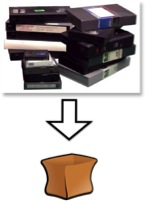Mezzanine Compression: 10 Pounds of Video in a 5 Pound Sack

PACIFIC PALISADES, CALIF.—For this month’s blog, I thought we’d go over mezzanine video compression. It’s become a hot topic again, especially in the area of moving real time video over IP networks.
First, some background on mezzanine compression.
Mezzanine compression is defined as a level of video compression that reduces the video bitrate (bandwidth) so it can fit into professional videotape or storage devices while not being too aggressive, thus retaining the overall quality of the video. Typically, mezzanine compression ratios are from 2:1 to 8:1. Various digital video tape formats used mezzanine compression: D5-HD (4:1), HD CAM (2:1), DVC Pro (5:1), HD CAM SR (3:1), DigiBetacam (8:1).
Key parameters for mezzanine compression are:
- Support for 10-bit depth (or higher)
- 4:2:0/4:2:2/4:4:4 chroma resolutions
- Intraframe encoding
- Multiple pass with minimal degradations
- HD and UHDTV format support
Today, the focus is on compressing live video signals being transported and distributed over IP networks. As has been discussed, the current transmission bandwidth of IP interconnects is 10 Gbps, which can carry up to three uncompressed HD signals, but is not enough to carry even one UHDTV signal. There are multiple implementations for mezzanine compression over IP:
- JPEG 2000 from Evertz
- TICO from IntoPix
- LLVC from Sony
- NDI from Newtek
The first three are wavelet-based, while NDI is described as ProRes-like (DCT-based). JPEG 2000 used in the Evertz EXE-VSR routing system is based on the ISO standard and supports multiple resolutions and formats, including HD and 4K.
TICO has been developed by IntoPix and is based on a lightweight implementation of JPEG 2K. Tico supports HD, 4K and 8K video formats and has low latency encode/decode with low complexity for implementation in firmware (e.g, field programmable gate arrays) as well as in software. TICO is in process of SMPTE standardization.
Low Latency Video Compression, or LLVC, by Sony, has been document in SMPTE RDD34. Using wavelet compression and a line-based entropy encoding, LLVC accomplishes low latency with line-based encapsulation.
NDI’s compression is designed to work in software and is the basis for Newtek’s Tricaster production system. NDI’s compression and SDK supports multiple video and audio streams transported over IP networks. NDI is supported on 32- or 64-bit Windows operating systems with Intel i3 Sandy Bridge CPU or better and a minimum of 4 GB of RAM. While not a I-frame-only codec, it provides for transparent delivery even with packet loss. The codec is based on a 8x8 DCT transform and supports 10-bit, 4:2:0,4:2:2 and 4:4:4.
The JPEG Standards Committee is also looking at standardizing mezzanine video compression.
While the criteria above are necessary, the key issue is going to be interoperability. Will multiple mezzanine methods be used and thus require multiple licenses and implementations? Or will one of these methods become the dominate method and become the de facto standard? In addition, will these compression standards be applicable for the storage and NLE applications? It could be very desirable to have one mezzanine compression standard, but is this necessary for adoption?
In one of the first large adoptions of mezzanine compression, ESPN uses it at the core of its new DC2 facility in Bristol, Conn. ESPN uses Evertz JPEG2K encapsulated in MPEG-2 transport, and delivered over the core EXE-VSR router based on 10Gbps switching. With ESPN’s more 4,000 simultaneous sources requiring simultaneous transmission to almost as many outputs, mezzanine compression in a 10Gbps switch fabric is a necessity.
While compression opens up bandwidth, there are also choices in terms of the amount of compression/bandwidth, bit depth (10-bit or higher) and the format of the video (4:2:0, 4:2:2, 4:4:4, HD, UHD-I or II). While HD generally is compressed between 100 and 200 Mbps, UHDTV is compressed at 250 to 500 Mbps. But at these rates, many compressed video signals can fit in a 10 Gbps infrastructure.
What does this mean? Well, mezzanine compression has proven to be workable for storage of video. Compressed video is in use for distribution and final delivery to the consumer. But will mezzanine video compression be acceptable for live video streaming inside a video production?
Get the TV Tech Newsletter
The professional video industry's #1 source for news, trends and product and tech information. Sign up below.

im DeFilippis is CEO of TMS Consulting, Inc. in Los Angeles, and former EVP Digital Television Technologies and Standards for FOX.
